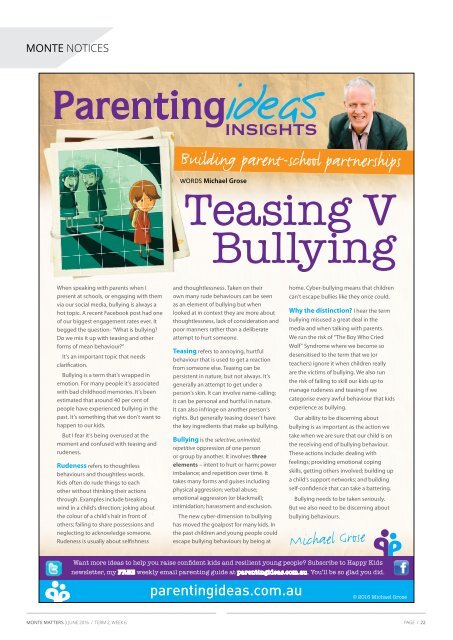MONTE MATTERS
mm_t2_w6_2016
mm_t2_w6_2016
Create successful ePaper yourself
Turn your PDF publications into a flip-book with our unique Google optimized e-Paper software.
<strong>MONTE</strong> NOTICES<br />
INSIGHTS<br />
Building parent-school partnerships<br />
WORDS Michael Grose<br />
Teasing V<br />
Bullying<br />
When speaking with parents when I<br />
present at schools, or engaging with them<br />
via our social media, bullying is always a<br />
hot topic. A recent Facebook post had one<br />
of our biggest engagement rates ever. It<br />
begged the question- “What is bullying?<br />
Do we mix it up with teasing and other<br />
forms of mean behaviour?”<br />
It’s an important topic that needs<br />
clarification.<br />
Bullying is a term that’s wrapped in<br />
emotion. For many people it’s associated<br />
with bad childhood memories. It’s been<br />
estimated that around 40 per cent of<br />
people have experienced bullying in the<br />
past. It’s something that we don’t want to<br />
happen to our kids.<br />
But I fear it’s being overused at the<br />
moment and confused with teasing and<br />
rudeness.<br />
Rudeness refers to thoughtless<br />
behaviours and thoughtless words.<br />
Kids often do rude things to each<br />
other without thinking their actions<br />
through. Examples include breaking<br />
wind in a child’s direction; joking about<br />
the colour of a child’s hair in front of<br />
others; failing to share possessions and<br />
neglecting to acknowledge someone.<br />
Rudeness is usually about selfishness<br />
and thoughtlessness. Taken on their<br />
own many rude behaviours can be seen<br />
as an element of bullying but when<br />
looked at in context they are more about<br />
thoughtlessness, lack of consideration and<br />
poor manners rather than a deliberate<br />
attempt to hurt someone.<br />
Teasing refers to annoying, hurtful<br />
behaviour that is used to get a reaction<br />
from someone else. Teasing can be<br />
persistent in nature, but not always. It’s<br />
generally an attempt to get under a<br />
person’s skin. It can involve name-calling;<br />
it can be personal and hurtful in nature.<br />
It can also infringe on another person’s<br />
rights. But generally teasing doesn’t have<br />
the key ingredients that make up bullying.<br />
Bullying is the selective, uninvited,<br />
repetitive oppression of one person<br />
or group by another. It involves three<br />
elements – intent to hurt or harm; power<br />
imbalance; and repetition over time. It<br />
takes many forms and guises including<br />
physical aggression; verbal abuse;<br />
emotional aggression (or blackmail);<br />
intimidation; harassment and exclusion.<br />
The new cyber-dimension to bullying<br />
has moved the goalpost for many kids. In<br />
the past children and young people could<br />
escape bullying behaviours by being at<br />
home. Cyber-bullying means that children<br />
can’t escape bullies like they once could.<br />
Why the distinction? I hear the term<br />
bullying misused a great deal in the<br />
media and when talking with parents.<br />
We run the risk of “The Boy Who Cried<br />
Wolf” Syndrome where we become so<br />
desensitised to the term that we (or<br />
teachers) ignore it when children really<br />
are the victims of bullying. We also run<br />
the risk of failing to skill our kids up to<br />
manage rudeness and teasing if we<br />
categorise every awful behaviour that kids<br />
experience as bullying.<br />
Our ability to be discerning about<br />
bullying is as important as the action we<br />
take when we are sure that our child is on<br />
the receiving end of bullying behaviour.<br />
These actions include: dealing with<br />
feelings; providing emotional coping<br />
skills, getting others involved; building up<br />
a child’s support networks; and building<br />
self-confidence that can take a battering.<br />
Bullying needs to be taken seriously.<br />
But we also need to be discerning about<br />
bullying behaviours.<br />
Michael Grose<br />
Want more ideas to help you raise confident kids and resilient young people? Subscribe to Happy Kids<br />
newsletter, my FREE weekly email parenting guide at parentingideas.com.au. You’ll be so glad you did.<br />
parentingideas.com.au<br />
© 2016 Michael Grose<br />
<strong>MONTE</strong> <strong>MATTERS</strong> 3 JUNE 2016 / TERM 2, WEEK 6<br />
PAGE / 22



